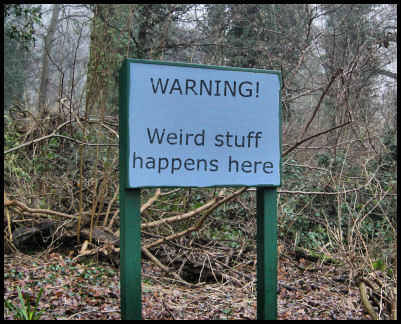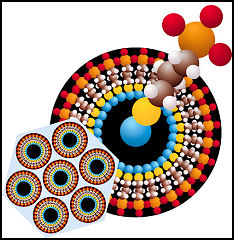Donald MacLean's Blog 14
NANO
After a year of looking back - remembering - I'm going to revert, this month, to a lifelong habit of looking forward.
Briefly.
Over the horizon.
It's a very strange scene. "THE NEXT BIG THING" is small!
VERY VERY small.
And very strange!
 |
"Insulators like silicon become conductors, stable materials like aluminium turn combustible, opaque copper becomes transparent and gold turns into a liquid which affects its surroundings in strange ways."
That's how I ended my blog Nr 7 ("Shrinkage") and, understandably, a number of you have pressed me to continue that story. ("It's as though you had played a 'dominant 7th' chord on the piano ... and walked away without resolving it"!)
It's nothing complicated that causes these weird effects - it's the simple act of making a piece of the material smaller.
And smaller.
And smaller.
In 1959 a Nobel scientist - Richard Feynman - gave a speech called "There's Plenty of Room at the Bottom" in which he challenged the world to produce a working electric motor so tiny that 64 of them would fit in a 1" cube. Mr Feynman envisaged some high-tech corporation developing a sophisticated machine to perform this miracle. But a year later the prize was won by one of my fellow Radio Hams ... Bill McLellan did it using his microscope and a pair of tweezers!
In the 50 years since then the big boys have got into the game and taken 'shrinkage' a great deal further ... this blog is about the dramatic consequences that are unfolding.
There are dozens of new technical terms in this weird miniscule world - you and I need only two:
"Nano" means "one billionth" ... eg a 'nanometre' ('nm') is a billionth of a metre. One of your hairs (not mine - I can't spare any) is about 75,000nm thick. The weird world we're considering here consists of things that measure less than 100nms - this area is called 'nano-scale'.
You probably know that the smallest unit of any material (while retaining the characteristics of that material) is a 'molecule' and that it consists of 'atoms' (common components of most materials). Well, atoms are mostly between 1nm and 100nm in size. Your finger-nails grow about one nanometre every second.
The other word is "Quantum - it means "the smallest unit of anything involved in an interaction". So it's not the same as 'molecule'. If you wish to delve into this murky area try googling "Quantum Theory" and "Quantum Mechanics". (And uncork the Glenmorangie ... you'll need it.)
(When you order a dram of my favourite medication you should accent the 2nd syllable - 'mor'.) (Thought I'd just mention that.)
So now you understand this Nano business, don't you?
Neither do I.
When you reduce the size of a piece of material down to the Nanoscale it starts to behave very differently.
I asked a scientist to help me understand this - he said "Averaging ... think of a bunch of even numbers, say a bundle of 10's ... they all look the same - but one of them can consist of a 7 & 3, another a 9 & 1, another a couple of 5's. So an even number can consist of a bunch of assorted odd numbers. A larger piece of any material shows the average characteristics of zillions of very small components all of which can be very different from the large piece".
 |
In 1981 Gerd Binnig and Heinrich Rohrer, working for IBM in Switzerland, created a microscope so powerful that it could tunnel down into any material until it displayed single atoms - a millionth part of a millimetre.
The "Scanning Tunneling Microscope" brought them a Nobel prize.
It brought the rest of us - you and me - the information that down at this level weird things are happening - like the examples I've quoted above.
And things can be in two places at once.
And things can be in two opposite states at once - like 'on' and 'off'.
These effects have been formalised as the "Uncertainty Principle". They can say that again!
Computer scientists will tell you (with a straight face) that this will enable machines that are half the size and work twice as fast.
In a nutshell - our traditional ideas of time and space now have to be modified.
This, apparently, has not inhibited some industries pressing ahead - the value of nano-enabled products sold worldwide in 2007 was estimated at $147billion.
State funding of nanotech R&D is interesting: the per-capita amounts are currently put at:
Germany $6.07
Taiwan $5.22
USA $5.06
France $3.28
Japan $2.99
UK $1.96
The catalogue of the century-old American outer-wear company Eddie Bauer already lists garments whose fabric is enhanced with nano-particles that make them stain-resistant.
In 2001 Toyota started using nanocomposites in a bumper that makes it 60% lighter and twice as resistant to denting and scratching. By the same year 60% of the sun-screen creams used in Australia incorporated nano-particles.
The catalogue of sports-good maker Wilson includes tennis-racquets and three golf drivers, a fairway wood, four balls and a golf bag all made of nano-materials.
The field of medicine abounds with applications exploiting the weird properties of nano-tech - it has opened-up new fields of exploration for cancer-cures.
Smith & Nephew markets a wound-dressing covered with nanocrystalline silver which rapidly kills a broad spectrum of bacteria. (The interior of our fridge is apparently coated with a similar material for that purpose).
 |
This pretty piece of abstract art is, we are asked to believe, a microscopic photograph of a piece of silica which has been dunked in a tank of liquid polluted with lead and mercury - it has harvested the pollutants which can now be removed and recycled. The things at the bottom-left are the nano 'sponge' ... "Self-Assembled Monolayers on Mesoporous Supports".
Note the "self-assembled"! There is already some public anxiety about
nano-technology (as with GM crops and stem-cell research). For example the possibility that someone will use these strange
alternative states to create a tiny robot that can replicate itself and, out
of control, might overwhelm the world with "Grey Goo". The internet provides lots of would-be reassuring papers
by scientists claiming that this isn't going to happen. But not one of
them says it couldn't. This may prove to be a parallel
to the nuclear-bomb situation with which we've now lived for half a century.
 |
|
“The patented nanotechnology in NanoBreeze decomposes allergens and mould spores; kills bacteria and viruses; reduces exhaust fumes and vapours." |
There are more immediate risks. I mentioned in Blog 7 that 3.8 new products using these strange alternative states are already coming onto the market every week. The "Project on Emerging Technologies" lists 807 products that use nanotechnology and which manufacturers have voluntarily identified - which is certainly just the tip of the iceberg.
Of course all of them pass the existing safety tests that protect us - but there is ample evidence that these protections are not appropriate to nano materials.
(In the EU, for instance, safety-regulation does not begin to apply until 1 tonne of a material is produced per year. Nano particles, of course, weigh so little that many of them may never even approach that threshold.)
Authorities in many countries recognise this problem - they have set-up a large number of bodies to seek a solution. Even a brief trawl of the internet reveals that none of them is yet succeeding. Discussion is still at the early stage of trying to define nano materials.
You and I should sympathise ... the nano revolution is crossing every discipline - every profession - every industry - every existing regulatory authority.
And the definition of Nano which I have given you above simply says "very small". One expert, wrestling with the problem of regulation, writes "This is like saying 'everything that is blue', or 'everything that is large' - the challenge we face here is hugely greater than any previous case."
So. Be in no doubt that in the next few years you're going to hear the word 'nano' increasingly. No development has ever remotely approached the breadth and the depth of the impact it's going to have on every aspect of our lives.
D.H.M.
"Anyone who is not shocked by
Quantum Theory
has not understood it."
Neils Bohr.
- - - - - -
Back to 'Contents' table
- - - - - -